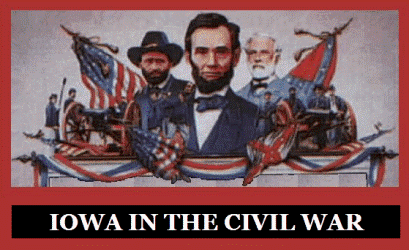The ranks of the blue-clad veterans of the
Grand Army of the Republic are rapidly thinning; the steps of the last
survivors are tottering and slow; it will not be long now until the last
man shall have answered the last call, and the organization which
started its existence 73 years ago will be only a memory on history's
pages, but what a memory of sacrifice and devotion and patriotism.
In the annals of the Grand Army of the Republic, the Iowa Department
has played an illustrious part. But its members, too, are monthly
answering the bugle blast of destiny and meeting their comrades on the
eternal bivouac beyond the river.
On March 1, 1939, there
remained in Iowa only 16 Posts of the G.A.R., of the 519 which had been
chartered; and only 29 Iowa members.
It is inspiring to stand and
salute the tottering veterans as they march, or ride, in their annual
national encampments, as Des Moines has had the privilege of doing twice
within recent years; but a day is drawing to a close in the history of
the nation which can never be duplicated no matter how long the United
States shall last.
The Grand Army of the Republic is a patriotic
association, organized in the interest of the survivors of the military
and naval forces of the Civil War. It was organized in Illinois in the
winter of 1865-'66, by Dr. B.F. Stephenson and Rev. W.J. Rudolph, the
surgeon and chaplain, respectively, of the 14th Illinois Infantry. The
first Post was organized at Decatur, Illinois, April 6, 1866; the first
national encampment was held at Indianapolis on Novemeber 20, 1866.
Iowa was one of the first states of the Union to attempt
organization of the Grand Army of the Republic, receiving as a
Department its first charter on July 12, 1866, signed by Dr. B.F.
Stephenson. But since its Department was not made permanent until 1879,
Iowa is cited as the nineteenth state in point of organization.
During the period of the provisional Department, from 1866 to 1879, Iowa
chartered over 130 Posts and elected nine Commanders, the first of these
being General Addison H. Sanders of Davenport. The first State
Commander of the permanent organization, dating from January 1, 1879,
was Hurlbut E. Griswold of Atlantic.
Of Grand Army Posts in Iowa,
519 were chartered altogether. Membership stood at its peak, in Iowa,
in 1890, when 20,324 veterans belonged to 435 Posts. In 1893 the number
of Posts had increased to 449, but the membership had declined to
18,870. From that time on there has been a steady decline in the number
of existing Posts and the membership. The records of the G.A.R., in the
State HOuse, at Des Moines, on March 10, 1939, showed 29 surviving
G.A.R. members belonging to 16 Posts and, in addition, 35 veterans whose
Posts have been disbanded, leaving these old soldiers members-at-large
of the G.A.R.
It is interesting to note that six veterans of the
Civil War have served as Governor of Iowa. They are:
Colonel
William M. Stone of Knoxville, 1864-1868
Colonel Samuel Merrill of
McGregor, 1868-1872
Colonel Cyrus C. Carpenter of Fort Dodge,
1872-1876
Captain Joshua G. Newbold of Mount Pleasant, 1877-1878
Captain Buren R. Sherman of Vinton, 1882-1886
Lieutenant Colonel
Francis M. Drake of Centerville and Des MOines, 1896-1898
To the
Grand Army of the Republic goes the credit for having instituted
Memorial Day, with all the tender and reverent patriotism which that
occasion always reveals, and for having kept alive, in history and
story, the brave deeds performed upon many a battlefield by many a
gallant soldier whose valor might otherwise have been lost to fame.
National Membership. The membership of the Grand Army of the
Republic was once over 400,000. On January 31, 1939, it was only
4,150. The death rate for that month was 165; so it can readily be seen
that the last man will have been mustered out within the next few years.
The G.A.R. has always been generous in providing for the needy
dependents of veterans and their families. Between 1880 and 1900 the
Iowa Department spent from $2,000 to $7,000 a year in the relief of
needy veterans, their widows, orphans and others. From 1897 on, the sum
spent for relief gradually dwindled. But the aggregate amount spent by
the Grand Army of the Republic throughout the nation, from June 30,
1887, to June 30, 1897, totalled $2,100,617. In addition, large sums
were spent for the purchase and distribution of flags to schools,
churches and various organizations, and aid was given in the erection of
monuments of Generals Grant, Sherman, and others.
The officers
elected and appointed at the 1938 encampment of the Iowa Department of
the G.A.R. were as follows:
Michael Hawk, Sioux City, Department
Commander
T.J. Noll, Des Moines, Assistant Adjutant and Quartermaster
General
Frank L. Quade, Dubuque, Senior Vice Commander
William P.
Allred, Corydon, Junion Vice Commander. (Died March 4, 1939)
James W.
Willett, Tama, Judge Advocate
J.J. Neuman, Des Moines, Chaplain
source: 1939-1940 Iowa Official Register, Thirty-Eighth Number; pg
353-354
Transcribed by: S. Ferrall
